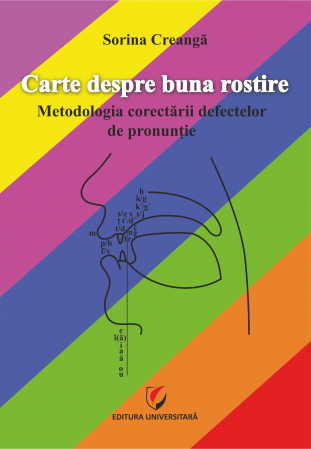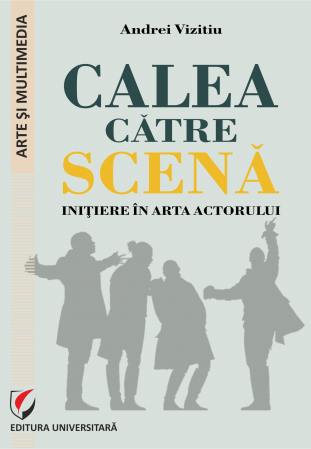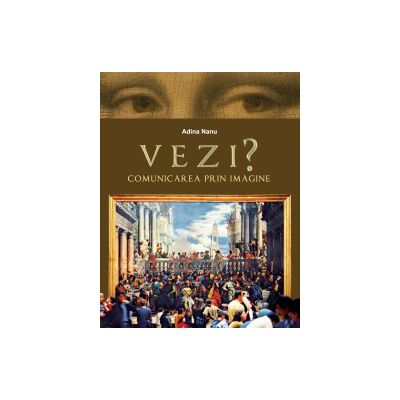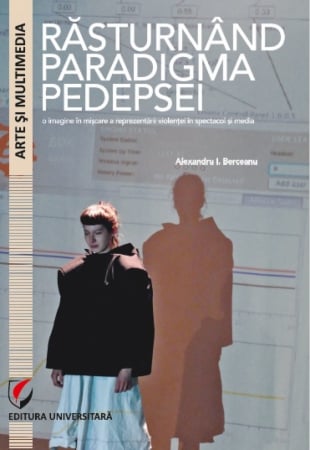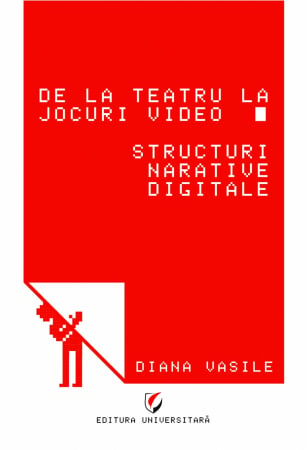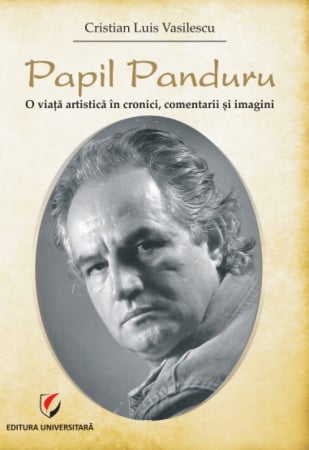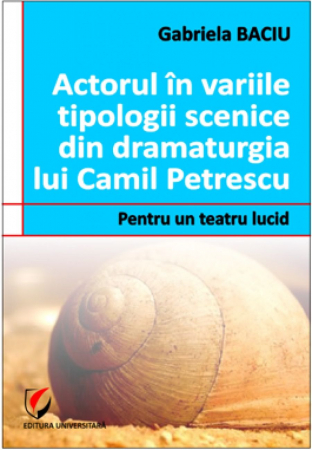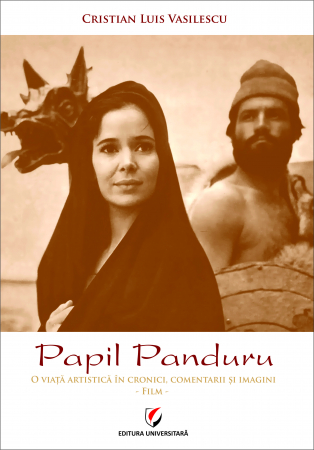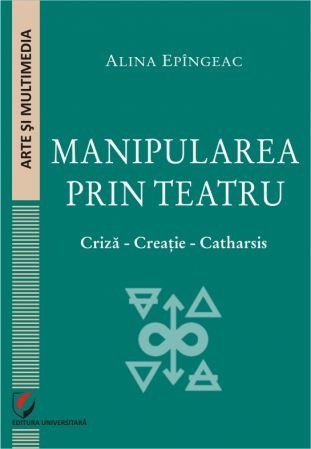6359.png) Peculiarities of Acting Creation from the Stage to the Media Universe (in the Diurnal Spiritual Reality) - Eugenia Serban
Peculiarities of Acting Creation from the Stage to the Media Universe (in the Diurnal Spiritual Reality) - Eugenia Serban
ISBN: 978-606-28-0754-2
DOI: 10.5682/9786062807542
Publisher year: 2018
Edition: I
Pages: 238
Publisher: Editura Universitara
Author: Eugenia Serban
- Description
- Download (1)
- Authors
- Content
- More details
- Where to find it
- Reviews (0)
Due to these data I was able to develop in my work such a special subject as the PARTICULARITIES OF ACTORIC CREATION FROM THE STAGE TO THE MEDIA UNIVERSE (IN THE DAY SPIRITUAL REALITY).
The Author
-
PARTICULARITATILE CREATIEI ACTORICESTI DE LA SCENA LA UNIVERSUL MEDIA (in realitatea spirituala diurna)
Download
Realism and Modernism / 4
European and Romanian avant-garde / 6
INTRODUCTORY NOTIONS / 3
I.1 The syncretism of the arts in stage creation / 30
I.2 Aesthetic theory of reception / 38
CHAPTER II. THE ESSENCE OF THE ACTOR'S ART / 63
II.1 Preliminary considerations: types of creators and artistic typologies / 87
Comic - general delimitations / 94
His comic writings / 102
The resizing of the comic in Caragiale's work / 105
Types of comics / 105
Aesthetic conceptualization of comedies / 112
II.2 Reception of the work of art: from contemplation and analysis, to comprehension and recreation / 117
II.3 The rebellious actor or “dreamed disobedience”, a way of assuming the essence of acting art / 121
CHAPTER III. EXPRESSIVE MODALITIES OF THE STAGE COMMUNICATION RELATED TO THE ACTOR / 128
III.1 Analysis applied to a text reading / 140
III.2 Medea, from the mythological heroine to the dramatic characters / 142
III.3 Premises for an open diversity of scenic expressions / 144
III.4 Jean Anouilh's Medea or the Light Behind the Shadows / 154
III.5 Medea-Jason, an archetype of dualism / 159
CHAPTER IV. THE ROAD OF THE FILM ACTOR TOWARDS HIMSELF / 160
CHAPTER V. ACTRESS EUGENIA SERBAN, FROM THE ART OF THEATER TO CINEMATOGRAPHY AND TELEVISION / 188
CONCLUSIONS / 194
BIBLIOGRAPHY / 200
The actor is a dramatic character, due to the dual nature he has impregnated in his being. On the one hand, it exists in the imaginary universe, in the intimate fiction of the play, and, on the other hand, it exists, as a real presence, in the closed universe of the show. Speaking his stage speech, his role, the actor is the main image vector of the message that the dramatic text carries in itself, so that through his utterance, but also through his gestures (the so-called non-verbal language) the actor becomes the one who gives the life and dramatic intensity of a universe closed to him. Indeed, the actor is the one who, for the spectator, unambiguizes the discourse, gives meaning and significance to the messages of the author and his characters, giving these characters the chance to be concrete in the universe of the stage and, equally, in the minds of those who are spectators.
The art of modern entertainment was generated and maintained by a necessity! The man of today, in spite of all appearances, is and remains a thirst for illusions and carries in him an inexhaustible capacity to delude himself. Therefore, using the game of illusion, as well as the search, loss and retrieval of illusions, the actor gives life to a mysterious and tempting universe in which no one knows where reality is hidden. This plausible fiction is the only one able to give the illusion of life. Which means that the embodied characters and the situations / conflicts on which the action is based, must represent the very deciphered essence of life, which, in fact, the viewer seeks to obtain. And, when these actions cross the severe border of the stage and the screen, they can become desires, aspirations, dreams.
The theater is the ideal space for the exchange of values and experiences in progress, in terms of means of artistic expression. And this truth was strongly emphasized especially in the post-war period, that is, when there was a deep overcoming of the boundaries between artistic genres, until then separated by certain formal boundaries, considered to be immutable. Syncretism sought an ambitious answer to this desideratum of modern creation. It was prepared and preceded by a series of courageous and ambitious openings that can be located from the end of the 19th century and the beginning of the 20th century. Such authors have as authors and promoters, both in terms of theory and theater, Duke Georg II von Meinigen, Richard Wagner, Adolphe Appia, Gordon Craig, Vsevolod Meyerhold, members of the current called the Bauhaus Movement, as and Alexandr Tairov and Antonin Artaud.
Syncretism put into practice a beneficial exchange between the arts, and this proved to be to the advantage of all genera and species engaged in the process.
The syncretism of artistic formulas corresponds to the synthesis of approaches, the multidisciplinary approach that studies information and artistic perception in all its richness and complexity. And the director is, in a way, the guarantor of the implementation of syncretism.
The affirmation and confirmation of syncretism are inseparable, organically related to what has been called the "civilization of the image", that is, to the importance that the visual has acquired and confirmed in the space of the human-universe relationship. In the field of theatrical art, this fact was achieved through the new identity that the scenic image of the staging acquired in relation to the actual text of the play.
Through a subtle process of synthesis and through an uninhibited dialogue between two or more arts, new genres have emerged, such as: image theater, gestural theater, dance theater, environmental theater or equestrian theater, which have resized the universe of the term theatricality, in accordance with the spirit of interdisciplinarity and with the need for synthesis of the contemporary world. And the symbols, unlimited in time and space, of authentic art, mutually potentiate, complement, contradict and highlight themselves better and more consistently than they could have done in isolation or sporadically. Certainly, in the future, the searches and projections in the sphere of theatrical syncretism will know increases and gains, both by deepening and by diversification, imposing itself as an aesthetic value and a superior human substance.
The syncretism of the artistic formulas corresponded to the synthesis of the approaches, the multidisciplinary approach that studies the information and the artistic perception in all its richness and complexity. Let's not forget that the art of the show is built and based on the relationship between actor and spectator, a relationship that can give rise to sympathy or antipathy and, in the most unfortunate case, indifference on the part of the spectator. There is a need, from the actors and directors, for a science of good knowledge and, as much as possible, of anticipating the spectator's reactions, supported by a knowledge of his expectations, desires and rejections. Such a "critique of taste" is itself a frontier discipline, at the interference between aesthetics, sociology and psychology, which sheds new light on the creator-work-receiver relationship.
Through its postulates and conceptual tools, reception theories have radically changed the meanings of the category of receiver of the work of art.
Unfortunately, the consumerist mentality on culture, more and more extended in time and geographical space, reduces culture, mechanically and simplistically, to its easiest form: fun. It is a warning that those who create works of art, but also those who make the transition from written text to the show on stage or on the small screen, must take into account.
The return of art to its essential mission, the rediscovery and re-assumption of aesthetic primacy and, through this, the re-modeling of public taste and the re-education of the receiver, are (or must be or become) priorities of actors and directors. And, equally, of the playwrights.
At the heart of dramatic art (in the broadest sense of the word) is the actor. This artist carries in himself a mute world which, in its loneliness, risks being lost and disintegrating. Therefore, the "key" of this world under the seal of mystery must be sought, and this key is in the hands of the director. He, the director, is the one who can and must bring to the stage the original sounds of the play. In turn, the actor learns to express himself and to express his secret.
For a closer representation of the understanding of this phenomenon called "actor's art" we tried to refer to some of the most suggestive theoretical approaches offered by some theater theorists, but also directors at the same time: Adolpfe Appia, Gordon Craig, Mihail Stanislavski and Jerzy Grotowski.
In Appia's programmatic vision, the actor is the one who has the gift and the purpose to achieve the happy meeting between music and word. The inner movements of feelings, proper to the moral construction of the characters, are expressed and valued only through music. The actor dominates the scene through music and also through music he expresses reality. For Appia, the actor is the one who and through whom space and time are ordered, in him, in the actor, the four dimensions being concentrated. In this way, in the being and in the condition of the actor, plasticity takes the place of individuality, and the light itself becomes the vivid color, that is, the "denial of the painted decoration".
The revolution that Craig brought in the way of thinking the actor-character relationship comes from the inverse perspective that the English theorist proposes; if until him it was about the "entry" of the actor in the skin of the character, in Craig the condition is exactly the opposite. The actor no longer "enters" the character's skin, but "leaves" it. This exit, as total as possible, also incurs a certain detachment of character, a gesture that produces a differentiation between art and reality, between two worlds that are still confused in the artist's mind. The personification of acting becomes a puppet. A puppet that enters into a direct rivalry with life itself, a puppet that goes beyond the limits of life. So, a puppet that will no longer represent, a body in flesh and blood, but the body itself in a state of ecstasy, while from it, from the puppet, will emanate the very breath of life. Thus, the puppet will dress in the strange beauty of death.
Going on this vein of death, for Tadeusz Kantor, the actor is the one who enters the scene and must be perceived by the spectator as a stranger from the realms of death. He wears his clothes, insignia, and yet looks so much like living people. This is, Kantor writes, the image of the actor "the animated image out of darkness", and he wants to find such an actor in his own theater, along with that "frightened astonishment" that the sight of a dead person or the encounter with a living man causes. the ghost.
Perhaps the most fruitful, contested, approved or rethought theatrical aesthetic is that of Konstantin Stanislavski, where the actor represents the cardinal element of the very idea of theater. The actor is the only element of the scene, the one who, through the force he has, can express the dramatic world in the subtexts, and this performance can only be obtained through a long process of improvement.
The analysis of the theatrical creative act that Stanislavski constructs has as a strong point the stimulation within the creative / interpretative act of the unconscious through the conscious. Stanislavski conceived of art as a way of living life consciously or unconsciously through inspiration. Emotions guided by the processes of psychotechnics - the method that can control the creative processes - can help to materialize an acting game in its purest state. A role becomes true only when the actor thinks and acts in a logical, consistent and human way. The actor must conceive and act out his role in accordance with his intimate human nature. And this is always done only in a direct consistency with the ultimate goal of art, which is to create a truly human spiritual life of the characters played. We can say that Stanislavski is also the first theorist of the film actor, even if it is more an extrapolation of the real data, than a mystification of the truth. Faced with a new language of artistic expression, with a technology and a procedure unprecedented in the performing arts, in the beginning the film actor is forced to support those who can guide him: the film director and, in the case of Russian cinema, the theorists of film.
The technical entanglements forced the actor to rethink his technique, position himself in front of himself and to resort to internal resources in a way he had never done before. The foreground and the fragmentation of an action into small pieces, the impossibility of living the character's experiences in the natural chronology, the obligation to build pieces from the role in a very short time, of a few seconds, which could not be chiseled in another day, the discovery of the new way of using one's own voice were some of the obstacles overcome by the actors in adapting to the new language. It is true that they were able to take over the theatrical heritage, but cinema and later television demanded a malleability not only different intellectually and physically, but also a different recreation of the self. We showed in the chapter dedicated to the relationship between the theater actor on the one hand and the film and television actor, on the other hand, what are the similarities and what are the differences between the two works of being the character. The relation of the film actor to the spectators is also diametrically opposed to the public-actor relationship in the theater, which led to the birth of the Hollywood star-system and the danger of easily dissolving the work with oneself. Television with its reality shows and live programs is a danger to the recognition of the actor as a unique being in the art of dramatic performance. But the human being has in his sensory DNA a fascination for the enigmatic.
And the actor is - according to George Banu - "the most enigmatic part of the theater". From any corner of the world, the "disobedient actor", mannerist or natural, in transvestites or old man, whether he plays with his face facing us or just turned his back on us, the actor "writes on the sand" and a memorialist , maybe for the time being anonymous (or not), reveals, in due time these traces, to those who will come.
Customer Support Monday - Friday, between 8.00 - 16.00
0745 200 718 0745 200 357 comenzi@editurauniversitara.ro
![Peculiarities of Acting Creation from the Stage to the Media Universe (in the Diurnal Spiritual Reality) - Eugenia Serban [1] Peculiarities of Acting Creation from the Stage to the Media Universe (in the Diurnal Spiritual Reality) - Eugenia Serban [1]](https://gomagcdn.ro/domains/editurauniversitara.ro/files/product/large/particularitatile-creatiei-actoricesti-de-la-scena-la-universul-media-in-realitatea-spirituala-diurna-244-2274.jpg)
